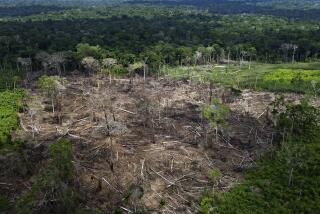Glow-in-the-dark cockroach among top 10 new species of 2012
Scientists estimate that there are about 8.7 million species on Earth, give or take 1.3 million. (Some believe that the true figure is even higher.) Of these, perhaps 1.2 million to 2 million have been officially identified -- the rest are still out there, awaiting discovery.
To some taxonomists, the urgency to find these forms of life is greater than ever. The loss of biodiversity threatens to drive some species to extinction before their existence ever goes on record. Researchers have identified new species at a rate of about 18,000 a year, but that’s too slow to close the gap.
“Knowing that millions of species may not survive the 21st century, it is time to pick up the pace,” Quentin Wheeler, an entomologist at Arizona State University in Tempe, said in a statement.
Wheeler has taken this problem to heart. As the founding director of ASU’s International Institute for Species Exploration, he has challenged the scientific community to identify 10 million additional species by the year 2063. Doing so would require a huge commitment -- a “NASA-like” effort, he says -- but it would provide humans with information that could help us live more sustainably.
To bring attention to the plight of undiscovered species, the institute has compiled a top-10 list of species that were identified in 2012. The winners were selected by taxonomists, the scientists who organize the natural world into categories and give each species an appropriate name.
More than 140 species were nominated. Here’s a look at the winners:
Viola lilliputana: The Lilliputian violet stands only 1 centimeter tall and grows in only one place in the Peruvian Andes.
Chondrocladia lyra: This carnivorous sponge lives about 2 miles below the surface of the northeast Pacific Ocean, off the California coast. The sponge resembles a menorah with 20 or more candles -- yellowish balls at the top stand in for flames.
Cercopithecus lomamiensis: Residents of the Democratic Republic of the Congo have been familiar with the lesula monkey for years, though scientists didn’t see it until 2007 and only gave it an official classification last year. The monkeys have a delicate, human-like face surrounded by a frill of fur.
Sibon noalamina: This harmless snake lives in the highland rain forests of western Panama and eats snails, slugs, earthworms and amphibian eggs. It wards off potential predators thanks to its resemblance to poisonous coral snakes.
Ochroconis anomala: This black fungus stains the prehistoric art on the walls of Lascaux Cave in France.
Paedophryne amanuensis: This frog is even smaller than the Lilliputian violet, with adults averaging a mere 7.7 millimeters in length. The brown-and-black mottled amphibian was found in New Guinea.
Eugenia petrikensis: This endangered evergreen shrub grows about 6.5 feet high and displays clusters of dark pink flowers. The shrub once grew along a 100-mile band in Madagascar; now it’s found only in isolated pockets.
Lucihormetica luckae: This cockroach glows in the dark. A single specimen was discovered 70 years ago in Ecuador, and scientists fear that it may be extinct already.
Semachrysa jade: A photo of this green lacewing insect was posted on Flickr and happened to be spotted by an entomologist with the California Department of Food and Agriculture, who thought it might be a new species. He was right.
Juracimbrophlebia ginkgofolia: This species of hangingfly lived during the Middle Jurassic under the leaves of a tree that resembled a ginkgo. The fossil was found in China’s Inner Mongolia region.
You can read more about all of these species on the International Institute for Species Exploration website.
Return to Science Now.







